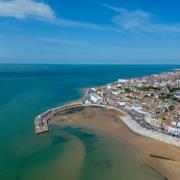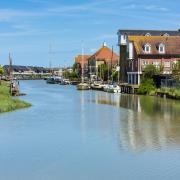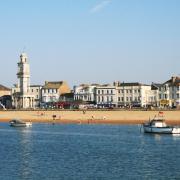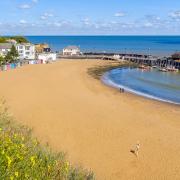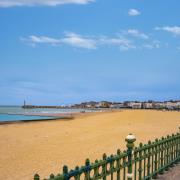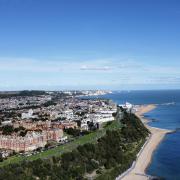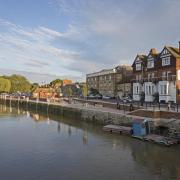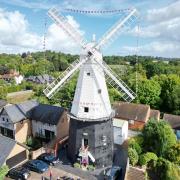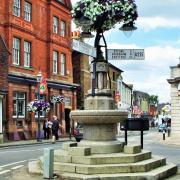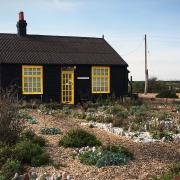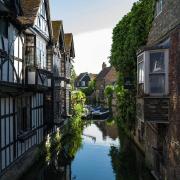We visit Hythe and New Romney to discover what lies in store for visitors to this very special landscape

1. Unique railway
The Romney, Hythe and Dymchurch Railway, a heritage rail line running across the Romney Marsh with stations from Hythe to Dungeness, is one of the best ways to see all this fascinating area has to offer. Operating the world’s most complete collection of one-third full-sized locomotives, you can hop on and off to explore along the way.
2. Peaceful Hythe
Hythe was a bustling centre for trade until its harbour started to silt up 300 years ago. Famed for its pretty pebble beach, popular with families and watersports enthusiasts, and lined with a parade perfect for a relaxing seaside walk, it’s a quiet place away from it all. Nearby is Lympne with its medieval castle, and Port Lympne Reserve wild animal park.

3. Meet the marsh
The Romney Marsh is famous for its flora and fauna, with a distinctive landscape made up of woodlands, flat wetlands and stunning coastline. With huge skies and clear air, Romney Marsh offers 100 square miles of unspoilt countryside. Learn about its wildlife at Romney Marsh Visitor Centre in New Romney. Run by Kent Wildlife Trust, the 11ha reserve features trails to follow and the centre itself houses displays about the natural history of the marsh.
4. Shingle desert
Set on the headland at the southern tip of the Romney Marsh, Dungeness is a vast shingle beach that looks for all the world like a desert but actually offers a unique habitat for all sorts of plants and animals and is home to a National Nature Reserve and the RSPB’s oldest reserve.
The scattering of buildings include ramshackle wooden huts, an imposing power station and old industrial buildings, frequently now converted into quirky holiday homes. Popular with artists and photographers, Derek Jarman famously lived here, drawn by the romance of the peninsula’s seclusion.

5. Food and drink
With such rich agricultural soil and proximity to the sea, it’s no wonder the area is famed for its food and drink. Farmers, fishermen and artisan producers offer everything from vegetables and seafood to ales and cheese, while Romney Marsh lamb is particularly prized as raising sheep on the salt marshes infuses the meat with a unique salty taste.
Fish straight from the sea features on most menus and there is a good choice of seafood restaurants and fish and chip shops; fishmonger Griggs of Hythe, set right on the beach, even serves an al fresco brunch on picnic tables overlooking the sea.
Great places to eat and drink include the Hythe Imperial, The Red Lion in Hythe, Hythe Bay Seafood Restaurant, Wells Restaurant in Hythe, Mary’s Tearoom in Dymchurch and The Woolpack in Warehorne. Don’t miss a visit to Hendrick’s of Hythe, a finalist in three categories in our 2017 Food & Drink Awards, to sample their gorgeous hand-made truffles and chocolates.

6. Old bones
It’s not everyone’s cup of tea but Hythe’s St Leonard’s Church has one of only two ossuaries, or ‘bone houses’, in the country. Home to Britain’s largest collection of human bones and skulls, the crypt is thought to contain the remains of around 2,000 individuals. Dated from between the 13th and 15th centuries, these bones are thought to belong to people who had originally been buried in the churchyard and were moved during an extension of the building centuries ago. Visit www.stleonardschurchhythekent.org
7. Unmissable events
There are several fun events to add to your calendar if you’re planning a trip to the area. Hythe hosts the fabulous Hythe Venetian Fête every other year, with decorated floats sailing down the Royal Military Canal and a firework display.
The town also has Hythe Festival of Arts and Culture in July, with parades, heritage trails, entertainment and a canal bank concert. JAM on the Marsh is an annual multi-arts festival set in the marsh’s medieval churches, when for two weeks each July a lively programme of events reach from Dungeness to Hythe and Lympne to New Romney.
8. Coastal villages
An historic coastal village with links to smuggling during the 17th and 18th centuries, Dymchurch was the main setting for Russell Thorndike’s Doctor Syn novels.
This stretch of coast is also famous for its Martello Towers, built to defend the country during the 19th century. Examples can be seen along the beach at Dymchurch, as can Dymchurch Redoubt – a station built to supply the chain of towers. Nearby Littlestone is where the remains of a wartime portable Mulberry Harbour can still be seen at low tide.
And if seaside walks are your thing then you will be spoilt for choice with excellent beaches all along this coast, including Hythe, Greatstone, Littlestone, Dymchurch and St Mary’s Bay.
9. Wonderful waterway
Stretching 28 miles from Seabrook to Cliff End near Hastings, the Royal Military Canal borders the Romney Marsh and was begun in 1804 as a means of defence against French invasion. Today a public path runs the length of the canal and is popular with walkers, cyclists and anglers. The canal goes through the centre of Hythe and electric boat trips and rowing boat hire are both available.
10. Wartime wonders
Open weekends from Easter to September, the Romney Marsh Wartime Collection houses a collection of wartime equipment, remains recovered from aircraft crash sites and memorabilia.
An independent trust, it is dedicated to the memory of those on either side who served their country during wartime. Incorporating the Brenzett Aeronautical Museum and set in buildings used as a hostel for the Women’s Land Army, the museum also has a Barnes Wallis Damnbuster bomb on display outside.




